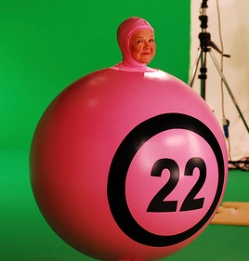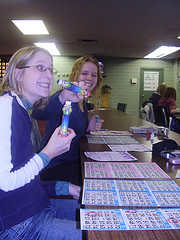Welcome to BINGOHIO
The latest information on where to play.
BINGO 101: Your first bingo session
Ok, you’ve found a convenient game on the BingOhio website. You’ve called some friends, and you’re all on your way to win big at your first bingo session. What should you expect when you get there?
Bingo is a social game…the players are usually very friendly. If you’re new to bingo, you’ll make many friends your very first time that will be more than happy to help you understand everything and have a great time.
THE BINGO HALL
A variety of facilities can be used as a bingo hall. It may be a local church basement, a party center, a former supermarket, or a converted warehouse. Many are multi-purpose facilities that serve many other functions on non-bingo days.
Bingo halls often had a reputation of being dark grungy rooms with smoke so thick you couldn’t the player sitting next to you. Not so anymore. While the quality of the room itself can range from a church basement to a decked-out party center, very few fit the old stereotype. In addition, the recent passage of no-smoking laws in Ohio has made the atmosphere in today’s halls clean and pleasant.
FIND A SEAT
Select an available seat or group of seats for you and your friends. You should be able to comfortably see the bingo caller, one or more flashboards, and a video monitor (if the hall is so equipped). Stake out your seat, then go up to the cashier and purchase your package.
AT THE CASHIER
The cashier’s station will have copies of the session’s game schedule or program available for you to take. Make sure you get one so you know all the games that will be played during the session and what the prize payouts are. The program will also show you the locations of breaks and intermissions.
Usually the cashier station has a sign which shows the price and content of each of the buy-in packages they sell. If you have any questions, the cashier will be happy to help you. Start slow at first…buying more cards than you can comfortably play will make for an evening of frustration…not fun. Also, the bingo console has a built-in timer, and balls are usually called based on the timer setting. Buy a small package at first…you can always step up next time as your comfort level builds.
Also, buy a package within your budget. If you overspend, you may regret it later. Save some money for the snack bar, extra sheets for the high-payout games, supplies, and of course some instant bingo tickets.
Virtually all halls sell consumable supplies such as bingo daubers. Sometimes these are available from the cashier; sometimes they’re sold at the snack bar. If you don’t see them, ask the cashier.
WHAT’S THE DAUBER FOR?…DON’T THEY USE HARDS CARDS AND COVER THE NUMBERS WITH PENNIES?
While there may still be an occasional bingo game that plays this way, Charity bingo in Ohio today is virtually all played on disposable paper sheets, with anywhere from one to eighteen bingo faces printed on each sheet. These sheets are marked with special bingo ink daubers. Each sheet has a different color border designed to make it simple to be sure you’re playing the right sheet on the right game (game 1 is played on a blue border sheet, etc.) When the game is over, rip the used sheets off the pad and throw them away…and you’re immediately ready for the next game.
THE CASHIER ASKED ME IF I WANTED A COMPUTER…WHAT’S THAT ALL ABOUT?
Computers are everywhere today, and bingo halls are no exception. Several manufacturers in the bingo industry have developed special computers designed to help you play bingo.
These are special handheld units that come pre-loaded with whatever size package you elect to purchase (by State law, a player may play no more than 90 faces by computer). When a number is called, you enter it in the computer, and it tracks each card for you. When you have a winner, it alerts you and displays the winning card, which can be verified by the game operator just like a paper bingo card.
These computer handsets are rented for the session from the hall operator, and are returned at the end of the session. They come with both black & white and color displays, and in several makes and models.
Some operators and players like computers…some don’t. In some geographic regions they’re in almost every game…in other areas they’re virtually non-existent. The arguments both for and against are many…its your personal preference.
YELL BINGO!
Before you start a new game, consult the program so you know what game pattern is being played. Make sure you’re playing the right colored sheet on the right game…it’s usually listed on the program…if you bingo on the wrong color sheet, you usually won’t be paid.
Often, the hall requires you to have the last number called in your bingo in order to win, so stay alert. So if the caller calls “B-12” and that gives you a bingo, make sure you yell BINGO before the next number is called…otherwise you may lose out.
Then, when you get bingo, yell BINGO…LOUDLY. It’s noisy up at the caller’s station, and it’s your job to make yourself heard.
HOW DOES THE HALL KNOW MY BINGO IS VALID?
Many halls today have bingo machines with computerized verifiers in them. The machine has all the bingo faces in its memory, and knows the pattern the hall is playing for on each game. When you yell BINGO!, a floor worker will come over to you and read back the number in the free-space square on your winning sheet to the caller. The caller just enters that number into the verifier, and your bingo card appears on TV monitors located in the hall, with your bingo card on the screen and your winning bingo pattern displayed for all to see. Its quick…It’s easy…and it eliminates errors.
I GOT A BINGO, BUT SOMEONE ELSE DID AT THE SAME TIME. HOW MUCH DO I WIN?
The amount listed as the prize for that game is the total prize money for that game. If more than one person win at the same time, the prize money is split. For example, if the pot for the game is $100 and two people get bingo on the same number, they each win $50.
Some bingo games play on multi-colored paper (usually white, green, and red). Depending on what color you bingo on determines your prize. For instance, bingo on White may pay $50, but a bingo on Green pays $150 or on Red pays $200. Multi-color paper is just another twist to add excitement and larger potential prizes to the program.
VISIT THE SNACK BAR
Bingo games normally sell refreshments. These can vary anywhere from basic pizza, hot dogs, and doughnuts to full dinners such as chicken or spaghetti with all the trimmings. Often the food is homemade by charity volunteers, and the prices are extremely reasonable.
IF YOU’RE SO INCLINED, TRY YOUR LUCK ON SOME INSTANT BINGO TICKETS
Along with traditional bingo, many halls sell tickets referred to as “instant bingo” (see Glossary of Bingo Terms” for more information). These tickets have a defined number of tickets in each set and a defined number of winners within the set. You can purchase these tickets (usually $.50 or $1.00 each), and open the tabs to see if you have a winning combination of symbols underneath that matches one of the winning combinations on the front. These tickets are often referred to as “instants”, “pull-tabs”, “paper slot machines”, or even “rip-offs”.
When the entire set is sold out and all the winners paid, the charity is left with a fixed profit.
Charity instant tickets usually have a far larger percentage returned to the players as prizes (75-80% or more) than other similar forms of gaming, such as Instant Lottery tickets, and far better action and playback as well.
The action on instant tickets can be fast and furious. Prizes can range from a free play to hundreds or thousands of dollars. Often there are several different boxes in play at once, and its not at all unusual for a player to win many big prizes on these in the same night.




